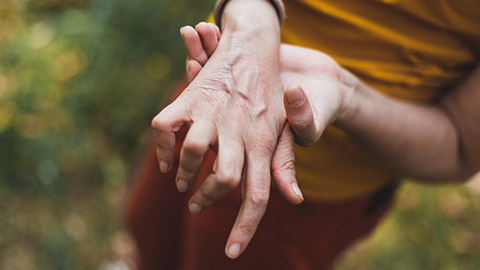
A client has a bewildering collection of signs and symptoms: hard, swollen ankles, a stiff elbow, fingers that “reverse direction”—what on earth is going on? It’s lupus, an autoimmune disease that can affect virtually every system in the body. It’s not always serious, but some of the consequences of the disease and of treatments for it have big repercussions for massage therapy clinical decisions.
Resources: 
Pocket Pathology: /abmp-pocket-pathology-app
Aringer, M. et al. (2019) ‘2019 European League Against Rheumatism/American College of Rheumatology Classification Criteria for Systemic Lupus Erythematosus’, Arthritis & Rheumatology, 71(9), pp. 1400–1412. doi:10.1002/art.40930.
Diagnosing Lupus - What is Lupus | Lupus Research Alliance (no date) Lupus Research. Available at: https://www.lupusresearch.org/understanding-lupus/what-is-lupus/diagnosis/.
González, L.A. et al. (2013) ‘Ethnicity in systemic lupus erythematosus (SLE): its influence on susceptibility and outcomes’, Lupus, 22(12), pp. 1214–1224. doi:10.1177/0961203313502571.
‘Lupus Update 2021: Classification Criteria, Disease Activity Measures & More’ (no date) The Rheumatologist. Available at: https://www.the-rheumatologist.org/article/lupus-update-2021-classification-criteria-disease-activity-measures-more/.


This podcast sponsored by:
Books of Discovery:www.booksofdiscovery.com
0:00:01.2 Ruth Werner: Hey, I Have A Client Who listeners, did you know I have a growing library of NCB approved one-hour online self-paced continuing education courses that you can do any time, anywhere? Well, now you know. Current classes include what's next COVID-19 updates for massage therapists and A Massage Therapist's Introduction to Pharmacology Part I, and brand new, A Massage Therapist 's Introduction to Pharmacology Part II. Classes are $20 each and they confer one hour of continuing education credit. Wanna know more? Visit my website at ruthwerner.com and check it out. Be sure to sign up for my mailing list so you'll never miss a new class.
[music]
0:00:47.6 Speaker 2: Anatomy Trains is delighted to invite you to our in-person fascial dissection workshop, May 30th through June 3rd, 2022. We're excited to be back in the lab with Anatomy Trains author, Tom Myers, and master dissector, Todd Garcia in Todd's laboratory of anatomical enlightenment in Boulder, Colorado. Join students from around the world and from all types of manual, movement and fitness professions to explore the real human form, not the images you get from books. Visit anatomytrains.com for details.
[music]
0:01:33.5 RW: Hi, and welcome to I Have a Client Who pathology conversations with Ruth Werner, the podcast where I will discuss your real life stories about clients with conditions that are perplexing or confusing. I'm Ruth Werner, author of A Massage Therapist's Guide to Pathology, and I have spent decades studying, writing about and teaching about where massage therapy intersects with diseases and conditions that might limit our client's health. We almost always have something good to offer, even with our most challenged clients, but we need to figure out a way to do that safely, effectively and within our scope of practice. And sometimes, as we have all learned, that is harder than it looks. Today's episode deals with one of the most complicated autoimmune diseases I can think of, lupus, and it comes from an open question from a massage therapist who shared this, they say lupus, anybody deal with contracted joints and finger joints that reverse direction. Is it within our scope to deal with the decreased range of motion, like say at the elbow joint and can it be helped, also ankle joints appear hard, swollen, not like they have pitting edema no pain with this just swelling. Gentle finger massage has been received nicely, but is there anything else that can be done? Client does not experience pain from any of these issues, I see this person once a month.
0:03:04.2 RW: Gosh, this is a hard one. I'm going to start by listing the things this massage therapist has noticed, contracted joints, fingers that reverse direction, I'm not sure what is meant by contracted joints and finger joints that reverse direction, that sounds like both limited range of motion and joint laxity at the same time, which is confusing. So let's let that go for just a moment, decreased range of motion at the elbow, is it within our scope to deal with this and can it be improved? Ankle joints are swollen and hard but not with pitting edema and no pain, just swelling. That sounds like indurated edema and I'll get back to that in a bit. Gentle finger massage goes over well, but the massage therapist wants to know if they can do more. The client has no pain related to their lupus and they get massage once a month... Well, about a dozen... It depends, flags are unfurling in my head at this moment, but before we talk about what it all depends on... Well, let's talk about lupus. If you have a client with this condition, the chances are good that what you observe maybe completely different from what this contributor describes. Lupus is just like that. It's a condition that presents differently from one person to another, and in spite of the house meme that it's never lupus, it's not an uncommon disease, it affects about 1.5 million people in the United States.
0:04:31.8 RW: Like many autoimmune diseases, lupus affects women more than men, at a ratio of about 9 to 1, it seems to be pretty clearly linked to estrogen secretion cycles for many women. Unlike most autoimmune diseases, though, lupus is diagnosed more often among people of color than among white people, and that might have something to do with genetic susceptibilities, but people of color also tend to have more serious cases and worse outcomes than white people, and that does not seem to be a genetic issue. That is more tied to access to health care and early intervention. Now, most autoimmune diseases like rheumatoid arthritis or multiple sclerosis or ulcerative colitis are fairly well defined. They describe an auto-immune attack against some specific tissues, the synovial membranes of certain joints for rheumatoid arthritis, the central nervous system myelin sheaths in multiple sclerosis, the lining of the colon in ulcerative colitis, but with lupus, the target tissues are much less specific. Lupus is notorious for creating antibodies that will attack almost anything. They can kill off thrombocytes leading to thrombocytopenia, they attack the lining of blood vessels leading to vasculitis with an accompanying risk for blood clots and stroke and heart attack and pulmonary embolism.
0:05:56.7 RW: They attack joints leading to massive inflammation, although it's usually without joint erosion, they attack the skin in various ways, causing rashes, hardened plaques and other lesions, that's the origin of the name, by the way, lupus refers to the wolf-like pattern of a malar rash, discoloration over the cheeks and the bridge of the nose, but maybe most dangerously, lupus inflammation can attack the kidneys, leading to thickened membranes in the nephrons, renal failure is one of the leading causes of death from this disease.
0:06:30.7 RW: All in all, lupus affects virtually every system in the body, leading to arthritis, strokes, anemia, seizures, hepatitis, pancreatitis, heart failure, kidney disease, and much more. Lupus comes in several subtypes. Sometimes it's related to specific medication use, and when the medication is stopped, then the symptoms subside without lasting damage, we call that drug-induced lupus, sometimes a person who's pregnant who has Lupus can pass dysfunctional blood components on to the baby, then the infant has some signs and symptoms of lupus called neonatal lupus, but it resolves within a few months, cutaneous lupus erythematosus is a version of lupus that is restricted to the skin. This is where we might see that characteristic malar rash or some other kinds of lesions, some of the lesions that develop with cutaneous lupus erythematosus sound a bit like what our contributor was describing with the indurated edema, but I'm not sure about that.
0:07:31.1 RW: Some people start with cutaneous lupus erythematosus and then later develop systemic lupus erythematosus or SLE. SLE is the classic form of lupus, and in our list of all the tissues that might be attacked, this is what we have just described, and some unlucky people have lupus in combination with other autoimmune diseases like rheumatoid arthritis, this combination is called rhupus, by the way, or scleroderma, polymyositis, dermatomyositis. When this sort of combination platter of autoimmune diseases happens, it is called mixed connective tissue disease. It can be hard to get a definitive diagnosis for lupus because it can look like so many different things, and because it often appears alongside other immune system issues, the American College of Rheumatology looks for a combination of at least four of the following things, and they do not have to appear simultaneously. Photosensitivity, oral or nasal ulcers, malar rash, discoid rash, non-erosive arthritis, pleuritis, pericarditis, kidney dysfunction, seizures, psychosis, anemia, leukopenia, thrombocytopenia, and the presence of lupus-specific antibodies and anti-nuclear antibodies. I just wanna say a quick word about these blood tests, lupus has some characteristic markers in the blood and they are indicative of the disease, indicative, but not definitive.
0:09:03.5 RW: People can have blood work that looks like they have lupus and not have Lupus, so this cannot be diagnosed by blood tests alone, and in the meantime, the kidneys may be under attack or the pericardium or even the central nervous system. Now, all of this sounds extremely dire and maybe even nightmarish, and sometimes that is the case, but of course, what I haven't talked about yet is that we have figured out ways to manage lupus with some success, and it is no longer the life shortening disease, it once seemed to be. The treatment goals with lupus are to promote remission, to limit tissue damage and to improve the quality of life for the patient. Just listening to that list, can you begin to envision a role for massage therapy here? I hope so. Mild cases can be managed with over-the-counter nonsteroidal anti-inflammatory drugs, with the caveat that overuse can be hard on the liver and the kidneys, and of course, that's a very specific concern for people who have this disease. More serious cases might require steroidal anti-inflammatories, at least for short periods, anti-malarial drugs seem to help with some of the skin symptoms. And really tough cases might be treated with chemotherapy drugs, whose job in this case is to tell the immune system to shut up and sit down. But of course, this has the risk of many possible adverse effects.
0:10:27.7 RW: The main thing is to keep on top of symptoms as they arise to prevent accumulating permanent tissue damage, and for the most part, this seems to be a fairly successful strategy, but what does it mean for massage? Well, let's return to our client. The contributor asked, "Anybody deal with contracted joints and finger joints that reverse direction? Is it within our scope to deal with the decreased range of motion, like say at the elbow joint and can it be helped? Also, ankle joints appear to be hard, swollen, not like they have pitting edema, no pain with this, just swelling." Again, I'm a bit stymied by the finger joints that reverse direction, but the contracted joints makes sense given that lupus can cause swelling and arthritis, I'm really curious though to know if this client might also be dealing with scleroderma since that autoimmune disease usually affects the hands making the skin thick and tough. Lupus and scleroderma are often seen together, remember, in that version called mixed connective tissue disease. We also hear about this client's decreased range of motion at the elbow. That might go to arthritis, I'm thinking, and about her hard, swollen but not pitting ankles.
0:11:45.8 RW: Edema is definitely on the list of lupus possibilities. I looked up indurated edema. That's a way of describing long-term fluid retention that becomes hardened, and it is sometimes a complication of lymphedema. So indurated edema as seen with lupus... Well, all I found there was information about hardened skin lesions and that didn't sound like this situation at all, so I'm at a bit of a loss for that one.
0:12:13.0 RW: However, lupus can in fact cause lymphedema because of damaged lymph nodes, but it doesn't seem to be a very common presentation. If this person is dealing with lymphedema, that is a very important piece of information. So what, in addition to gentle finger massage, can our contributor do to help with this person's quality of life? Here are some of the things, I think, those answers depend on. What is going on with her fingers that gives them the sense of a reverse direction? Does she have lymphedema and is that what causes the situation in her legs? If it's not lymphedema, does she know why her ankles are swollen and hard? How are her kidneys? What medications does she use to manage her lupus and/or any other conditions? One was the last time she had a flare-up? And, of course, our two most important questions, what are her normal activities of daily living? And what does she hope to accomplish with massage? Until we know the answers to these questions, I will suggest that anything other than very gentle, non-intrusive work might be too much for this client's system to handle. We don't know if her ankles are related to kidney dysfunction, lymph node damage, heart failure or something else entirely.
0:13:31.6 RW: Any of those answers suggest a problem with fluid management. That said, there's all kinds of ways to offer soothing, comfortable touch that doesn't challenge the kidneys or cardiovascular or lymphatic system. If she's taking steroids or chemotherapy drugs, her immune system is likely to be suppressed and that has implications about massage, of course. If our contributor can establish some baseline safety information, then I think doing some more specific work around the elbow in particular will probably be safe and welcome. It may or may not make a big difference, but just the caring touch in a difficult area can feel great. And who knows, maybe that stimulus as long as it doesn't cause pain or damage, might set some wheels in motion to improve the client's range of motion. I wish I had gotten some more specific information about this client, and they're very vague lupus symptoms, but truthfully, my experience is that most people with lupus have kind of hard to explain collections of signs and symptoms from hair loss to infertility, to disc-shaped lesions on their legs. The sequelae, the steps in the process that start with problematic antibodies and end with all these different presentations like a stiff elbow and big ankles, the sequelae are hard to parse out.
0:14:50.4 RW: Always in the background, we need to be aware of the big stakes lupus targets. The kidneys, the heart, the brain, and blood vessels, but if we can get enough information to know what this client can tolerate in terms of activity, then we can be sure to keep massage within those parameters, until we know more about their resilience.
0:15:11.1 RW: Hey, everybody, thanks for listening to I Have a Client Who pathology conversations with Ruth Werner. Remember, you can send me your I Have a Client Who stories to ihaveaclientwho@abmp.com. That's ihaveaclientwho. All one word, all lowercase @ abmp.com. I can't wait to see what you send me and I'll see you next time.
[music]